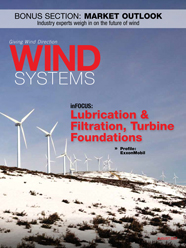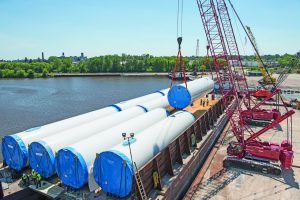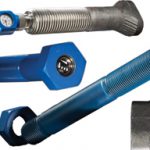ExxonMobil is a company name that pops into view practically every time a commuter gets behind the wheel of a car.
There’s a reason for that — it’s been around for a long time.
ExxonMobil is just as well known when it comes to wind energy for much the same reason.
“ExxonMobil has been involved in the wind industry since the beginning,” said Gary Hennigan, U.S. lubricants engineer for ExxonMobil. “We developed one of the first lubricants specifically formulated for wind-turbine gearboxes. And, today, our lubricants protect more than 40,000 wind turbines around the world — we’re supporting wind-turbine operators in virtually every market where the wind industry is active.”
Over the past few decades, ExxonMobil has worked with some of the world’s leading manufacturers of wind turbines, gears, and bearings through its Equipment Builder Group to gain insight into key wind-turbine equipment trends.
“This insight has enabled us to continuously develop new and advanced lubricant technologies to protect turbine components in even the harshest operating conditions,” Hennigan said.
Innovative Lubrication Solutions
Because of that, ExxonMobil develops innovative lubrication solutions in order to help operators meet their equipment and business goals.

“The quality of our products has always been a key to our success, and it remains a defining characteristic of how we support operators across many different industries,” Hennigan said. “This means working closely with OEMs and operators to understand the specific operating demands for their equipment so that we can develop advanced lubrication solutions that can enhance the reliability, performance, and productivity of this equipment. We want to help operators keep their equipment running for as long as possible without the need for unscheduled maintenance.”
Proper lubrication is critical for the inner workings of a turbine, so longer lasting lubricants can translate into equipment failure being reduced dramatically and potentially prevented altogether, extending the performance of a turbine even longer.
“Everyone in the wind industry knows that equipment reliability is critical to their success, profitability, and operational safety. They’d likely all agree that production loss from unexpected equipment downtime can be catastrophic,” Hennigan said. “Here’s where we come in.”
Specific Formulation
ExxonMobil has a specific lubricant formulation strategy that enables it to develop the industry’s most advanced synthetic lubricants, according to Hennigan.
For wind, specifically, ExxonMobil has developed novel lubricants and synthetic oils that include its newest synthetic oil, Mobil SHC Gear 320 WT.
The Mobil SHC Gear 320 WT synthetic gear oil is a good example of how the company’s formulation philosophy dovetails into a better product.
“It is our most advanced synthetic wind-turbine gear oil, designed to protect equipment from common issues such as scuffing, micropitting fatigue, and rust and corrosion,” he said. “It also ensures proper protection at extreme high temperatures and good pumpability at low temperatures.”
Lasts Longer
And one of the most important aspects of the synthetic oil’s formulation is that it lasts years longer than most conventional lubricants, according to Hennigan.

“It’s been proven to perform reliably for up to seven years at the very least, which is 40 percent longer than most conventional lubricants on the market today,” he said. “This performance is backed by an industry-leading seven-year warranty, which covers both the oil and the components the oil protects.”
It practically goes without saying that longer oil life
translates into better wind-turbine performance, which reduces O&M costs over the life of the equipment as well as enhancing worker safety. With wind-turbine technicians having to work 300 meters above the ground, safety among wind farms is always a paramount issue.
“By extending oil life by 40 percent over conventional lubricants, we can help operators reduce how often they have to change their oil, potentially even eliminating an entire service cycle over the standard 20-year life of an average wind turbine,” Hennigan said. “That means more turbine uptime, less money spent servicing the equipment, and reduced worker exposure.”
In addition to the Mobil SHC Gear 320 WT, ExxonMobil has also launched two other synthetic greases:
- Mobil SHC Grease 460 WT: This grease is specially formulated to lubricate wind-turbine yaw, pitch, and main bearings. It has become the first fill product of choice for many wind-turbine builders and component suppliers. It has proven outstanding performance in more than 10,000 wind turbines worldwide. Compared to conventional greases, Mobil SHC Grease 460 WT delivers longer grease life, enhanced false brinelling protection and bearing life, wide temperature range of application, and the potential for improved mechanical efficiency.
- Mobil SHC Grease 102 WT: This grease is scientifically engineered to meet or exceed the demanding requirements for severe wind-turbine pitch and yaw applications at extreme temperatures ranging from 120 degrees C down to as low as minus-50 degrees C.
Technical Services
To help with educating its clients about the value of its products, ExxonMobil offers technical services such as Mobil Serv Lubricant Analysis, which utilizes the latest used oil analysis (UOA) technology to keep lubricants performing properly and to monitor equipment condition in real time.
“Almost all operators are familiar with UOA, which is a tool that enables them to monitor real-time lubricant performance, so they can identify and address potential equipment performance challenges before they become a serious issue,” Hennigan said.
Mobil Serv Lubricant Analysis transforms the UOA process to help improve equipment and operational productivity. It streamlines the entire process, from initial sample gathering to final reporting, using a mobile-enabled platform that eliminates the need for paperwork. Operators use QR-coded scan-and-go bottles to easily deliver used oil samples to ExxonMobil’s oil analysis laboratory. Once these samples are analyzed, customers can access the results and customized equipment recommendations on their mobile or tablet device, according to Hennigan.
“The launch of this service builds on ExxonMobil’s long tradition of providing leading UOA services to companies around the world, and it’s yet another tool to help wind operators enhance their lubrication program,” he said.
Performance Challenges
Along with making sure its customer have the right lubrication for the right job, ExxonMobil is committed to making sure OEMs understand performance challenges common to today’s wind industry.
“One of those challenges is white etching cracking (WEC), which are sub-surface bearing failures occurring under fatigue load that are reported to cause 80 percent of wind-turbine high speed bearing failures,” Hennigan said. “There are many factors that contribute to the formation of WEC, but we partnered with Schaeffler, a leading bearing manufacturer, to better understand the role that lubricants play in causing WEC.”

ExxonMobil discovered that metal-based additives, such as zinc phosphate and/or a combination of over-based calcium and sodium, increased the sub-surface stress and enhanced hydrogen diffusion below the contact point, causing WEC formation, he said.
“In short, they’re one contributor to the problem,” Hennigan said. “During this research, we also confirmed that Mobil SHC Gear 320 WT, our newest gear oil, can help operators rule out one of WEC’s key suspects. Because of its metal-free formulation, Mobil SHC Gear 320 WT is scientifically proven to not contribute to WEC. So, while lubricants cannot prevent WEC formation altogether, using the right lubricants can help eliminate one of the causes of WEC.”
Delivering Long Lubricant Life
The products and services ExxonMobil offers are all focused on providing wind operators with the same benefit — delivering long lubricant life to help maximize equipment uptime and productivity.
“It’s important because when it comes to long-term lubricant performance, there has been increased focus on trying some less effective strategies,” Hennigan said. “I’m talking about mitigation strategies like top treating. To conduct top treating, operators use oil analysis to identify when an oil’s additives start to deplete and then re-additize that oil with the addition of after-market additive packages.”
But Hennigan said that approach is much like putting on a Band-Aid and doesn’t compensate for good formulation.
“I liken it to baking,” he said. “If you want to bake the best cake possible, then you need to use high-quality ingredients and ensure that all the needed ingredients are included in the cake mix at the right ratios before it is baked. You’ll be able to taste their quality in the final product, and poor quality ingredients will not result in a tasty cake. And, most importantly, once the cake is baked, you cannot go back and add ingredients without further ruining the cake. Say, for example, that you forgot to include vanilla extract. Trying to add vanilla flavoring to an already baked cake would not be possible, and even if you tried to douse the cake in extract, it would result in an uneven distribution of flavor.”

Hennigan said these same principles apply to an oil’s formulation. Additive top treating may introduce new contaminants that could affect equipment performance. Top treating also increases how often operators need to interact with equipment. While it may not be as invasive as flushing and changing an oil, it can increase the potential for safety issues.
Lubrication’s Impact
Hennigan noted a case study that showed the impact that lubrication can have on enhancing wind-turbine reliability and operator profitability.
“One West Virginia-based wind farm operated 44 wind turbines equipped with Flender gearboxes,” he said. “These turbines operated in a four-season climate, meaning they were exposed to regular rain, snow, and extreme high and low temperatures. While the turbines were operating just fine, the operator’s maintenance team wanted to see if there was an opportunity to reduce service interval frequency and enhance productivity.”
After a thorough inspection, ExxonMobil engineers recommended the company convert its gearboxes to one of its synthetic lubricants, as well as implement routine Mobil Serv Lubricant Analysis to monitor both lubricant and equipment condition.
“After making the switch, the company was able to extend its oil drain intervals to more than 49,000 hours — more than twice the industry average — while maintaining excellent gear condition,” Hennigan said. “These benefits helped generate company-estimated annual savings of $176,000.”
Challenging Task
Maintaining high wind-turbine reliability is no easy task. These machines operate in uniquely severe conditions. The gearboxes operate up to 350 feet above the ground and face conditions such as heavy and varying loads from strong winds, extreme temperatures ranging from 120 degrees C to minus-50 degrees C, and exposure to contaminants such as saltwater in an offshore environment.
“That’s why proper lubrication plays a critical role,” Hennigan said. “By using longer-lasting lubricants, you can reduce and potentially prevent wind-turbine equipment failures while extending the turbine’s performance even longer.”









































